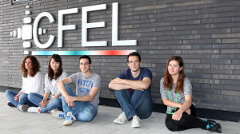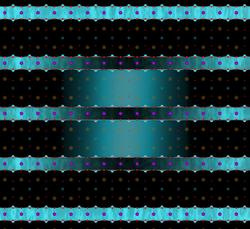- Accelerator Science
- Bio & Medical Physics
- Chemical Dynamics
- Condensed Matter Physics & Nanoscience
- Molecular Imaging
- Spectroscopy
- Strong Field Physics
- Theory
- Ultrafast Optics

A first hint of superconductivity at room temperature
Scientists of the Max Plank Institute for the Structure and Dynamics of Matter at the Hamburg Center for Free-Electron Laser Science (CFEL) have turned a normal insulator partially into a superconductor at room temperature, using a flash of infrared light. The superconducting state survived only for a couple of picoseconds (trillionths of a second), but the findings may aid the quest for higher temperature superconductors, as the team of scientists including Wanzheng Hu, Daniele Nicoletti, Cassi Hunt and Stefan Kaiser lead by Andrea Cavalleri from the Max Planck Institute for the Structure and Dynamics of Matter at CFEL reports in the scientific journal Nature Materials.
This picture shows a light-induced redistribution of interlayer coupling in YBCO. In the superconducting state, the pump light enhances the superconducting coupling between the copper-oxygen bilayers at the expense of the superconducting coupling within the copper-oxygen bilayers. A similar case is found for the normal state, that the laser light induces a superconducting coupling between the bilayers, meanwhile weakens the precursor superconducting coupling within the bilayers. Credit: Jörg Harms/MPSD,CFEL
Superconductors are materials that carry electric currents without any resistance. Even good normal conductors like electrical lines lose roughly six per cent of the power they transmit due to resistive losses, so developing a zero resistance material has immediate practical benefit. Various metals are natural superconductors, but only at very low temperatures around minus 270 degrees Celsius. In 1986 it was discovered that certain ceramic compounds become superconducting at somewhat higher temperatures. But even these so-called high-temperature superconductors have to be cooled to below minus 135 degrees Celsius, rendering practical applications difficult.
In their new work, the researchers focussed on a double-layered cuprate, a group of copper oxide based materials with various known high-temperature superconductors. The investigated yttrium barium copper oxide (YBCO) has the chemical formula YBa2Cu3O6.5 and becomes a superconductor below -223 degrees Celsius.
The exact workings of high-temperature superconductors are still a mystery. Generally, superconductivity occurs, because electrons in the crystal lattice team up in so-called Cooper pairs which allows them to travel without resistance through certain materials. Below a characteristic temperature, all the Cooper pairs move together like a herd and can quantum mechanically tunnel through thin insulating layers.
YBa2Cu3O6.5 has a double layered structure, with pairs of CuO2 planes. In the superconducting state, the Cooper pairs can tunnel effortless from one of these bilayers to another, the bilayers are coupled. In the normal state, the Cooper pairs seem to be still there, but confined to their own bilayer, and coupling occurs only within each bilayer.
As the researchers found, a flash of infrared light can clear the way for the Cooper pairs to tunnel from one CuO2 bilayer to another, this effect can be measured for a tiny fraction even at room temperature, and so giving the first hint that superconductivity at room temperature is possible. The infrared light lets certain oxygen atoms between the bilayers (the apical oxygen atoms) vibrate around their equilibrium position. "For cuprates, the distance of the apical oxygen to the CuO2 plane is believed to play an important role for how high the superconducting temperature can be," explains Hu. "Therefore, by modulating the apical oxygen position, we hope we can control the superconducting properties."
With the infrared flashes, the scientists could induce a superconducting state, but only in a small fraction of less than 20 per cent of the whole material. Also, the superconducting state vanished almost immediately. Still, the researchers hope that their work may lead to strategies for the creation of higher-temperature superconductivity over longer timescales. " The dream is to generate a homogeneous superconductor which has a long lifetime," says Hu. " Our goal is to develop a material that has the same properties, but without requiring light excitation-a true room temperature superconductor."



